History of The Felling
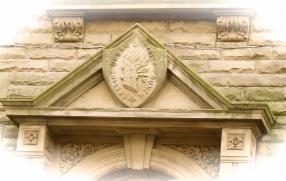 Why was Felling UDC's logo, carved into the very fabric of their building, incongruous? Read on
Why was Felling UDC's logo, carved into the very fabric of their building, incongruous? Read on
Go here for the videos of The Local History Exhibitions, hosted by The Felling Heritage Group in 2013 and 2014
Welcome to THE Felling History the web page that brings you a few facts and lots of old pictures about The Felling area. If you really want to know The Felling's history you need Joan Hewitt and her book The Township of Heworth but also see my Heworth vs Felling
and my Felling History blog
My Felling
by Joyce Wilson
Friendly and homely, knew everyone's face
Then they came and pulled it down,
Gone went the streets of our little town
The high street remains but it's looking forlorn,
The echoes of the past await a new dawn
The square at its centre was awash with colour ,
Passing folk meet to chat to one another,
Ladies with shopping, mothers with kids,
Dads going for a pint , 10 for a quid
Sunday was special, to Dragones we went,
The best ice cream around , was heaven sent,
Dads and sons came from the bars,
Meandered home across roads with few cars
Wednesday afternoon was a quiet affair,
Shops closed at one for the rest of the day,
The Felling will always be with me
Wherever I go,
The sights , the sounds,
The people I know
My Felling
"If London hadn't been London, The Felling would have been"
John Batie, a long time resident and fan of The Felling.
Not just London but New York are linked to The Felling on Tyne
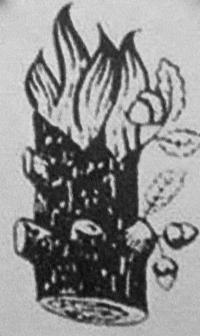
The Brandling burning brand.
Some might think, indeed I do, that it incongruous that a symbol, representing a wealthy landowning family that oppressed the workers, should be adopted by a Council which, for it's entire existence, was Labour controlled. Click the above link to see more on the burning brand
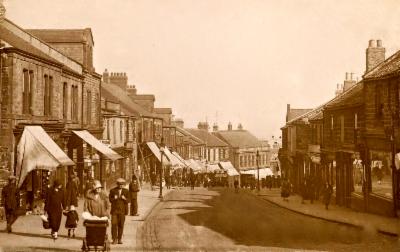
Left click to enlarge
Click if you want to see more pics of the once iconic High Street
And here And here
Most of the pictures on this web page are from Gateshead Council's fantastic photographic collection now available online at isee
Lots of old photos of The Felling/Bill Quay can also be found on Norman Dunn's excellent website
Welcome to The History of The Felling
For bits about Felling, High and Low
Windy Nook and Heworth,
That's Nether, Shore, and High also
There's Friar's Goose, Felling Shore and Wardley
And the Quay belonging to Bill
White Mare Pool and Follonsby
And should I include Carr's Hill?
Jon Bratton 2009
Let's start with "Why THE Felling?" Is there any other town in the World where its inhabitants use the definite article. It is normally used to refer to a person, place, or thing that is unique: "the Queen"; "the Mona Lisa"; "the Nile". So...there you have it. It's because The Felling is unique...you heard it here first. It is alleged, wrongly in my view, that it started at the very beginning. The place where the trees were felled was known locally as The Felling which gradually developed into its own Urban District in 1894. See my view on the derivation of the place name The Felling.
I'm not alone... Chas C Taylor also held that view
Note, the Council was merely called Felling Urban District Council but the canny folk of The Felling and others still use the definite article. In a 19th Century T. Fordyce book digitised by Google readily available on the internet the author regularly refers to THE Felling but I've also seen, in old books, other parts of The Gateshead Fell being called The Low Fell and The High Fell and the main pub crawl thro Low Fell is still called The Fell
Go here to read my take on the Early History of The Felling
People still to this day write and speak "The Felling" and I once studied a Facebook page to see the percentage usage and non usage of the definite article. It's about 50/50. I'll study it further to see if I can determine what dictates the use of the "The" but here's an example of both in a sentence "The Felling is full of canny Felling folk". Nobody uses the "The" in their address but I've just started. Join me. Add the "The" and see how long it takes to get a reaction from the Royal Mail
"If London hadn't been London, The Felling would have been"
John Batie, a long time resident and fan of The Felling.
Not just London but New York are linked to The Felling on Tyne
Some might think, indeed I do, that it incongruous that a symbol, representing a wealthy landowning family that oppressed the workers, should be adopted by a Council which, for it's entire existence, was Labour controlled. Click the above link to see more on the burning brand
Left click to enlarge
Click if you want to see more pics of the once iconic High Street
And here And here
Most of the pictures on this web page are from Gateshead Council's fantastic photographic collection now available online at isee
Lots of old photos of The Felling/Bill Quay can also be found on Norman Dunn's excellent website
Welcome to The History of The Felling
For bits about Felling, High and Low
Windy Nook and Heworth,
That's Nether, Shore, and High also
There's Friar's Goose, Felling Shore and Wardley
And the Quay belonging to Bill
White Mare Pool and Follonsby
And should I include Carr's Hill?
Jon Bratton 2009
Let's start with "Why THE Felling?" Is there any other town in the World where its inhabitants use the definite article. It is normally used to refer to a person, place, or thing that is unique: "the Queen"; "the Mona Lisa"; "the Nile". So...there you have it. It's because The Felling is unique...you heard it here first. It is alleged, wrongly in my view, that it started at the very beginning. The place where the trees were felled was known locally as The Felling which gradually developed into its own Urban District in 1894. See my view on the derivation of the place name The Felling.
I'm not alone... Chas C Taylor also held that view
Note, the Council was merely called Felling Urban District Council but the canny folk of The Felling and others still use the definite article. In a 19th Century T. Fordyce book digitised by Google readily available on the internet the author regularly refers to THE Felling but I've also seen, in old books, other parts of The Gateshead Fell being called The Low Fell and The High Fell and the main pub crawl thro Low Fell is still called The Fell
Go here to read my take on the Early History of The Felling
People still to this day write and speak "The Felling" and I once studied a Facebook page to see the percentage usage and non usage of the definite article. It's about 50/50. I'll study it further to see if I can determine what dictates the use of the "The" but here's an example of both in a sentence "The Felling is full of canny Felling folk". Nobody uses the "The" in their address but I've just started. Join me. Add the "The" and see how long it takes to get a reaction from the Royal Mail
As we commemorate the Centenary of WWI it is interesting to discover that a bloke from The Felling was reputed to be the first Brit to fire a shot in World War One...John Brown-King of Windy Nook
For more details of the J Brown-King story
Here's a bit of Heworth Common in 1766, basically fields owned by Charles Brandling, Edward Stewart and others.
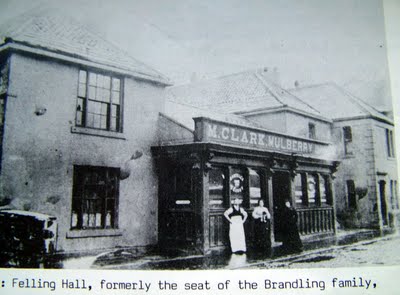
Apart from Felling Hall (seen here after it was turned into the Mulberry Tree pub) and
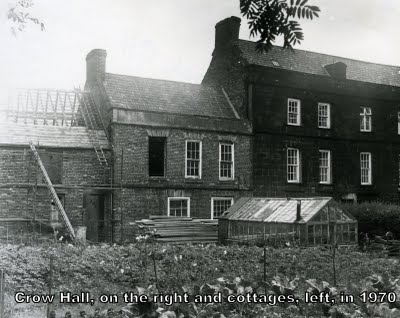
Crow Hall and Cottage, now Listed Buildings,
there's only a few houses clustered around the bottom of Split Crow Road, then called Sunderland Lane as that was the main route from Newcastle to Sunderland.
The predominant part of the area was originally known as Heworth.
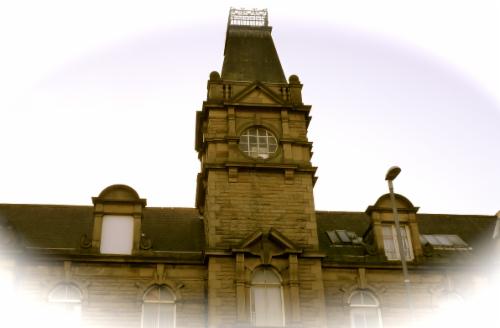
Left click to see Council crest above the door
This is the former Felling UDC Council Offices, now a Listed building, used for a time as a Housing Office, then later a refugee, and then a teenagers out of care, lodging. It is now appartments
Above the main door is a crest which was adopted by the Council but was originally the crest of the Brandling family, lords of the manor since the 16th century. The crest comprises an oak log with leaves and acorns attached, and flames coming out the top. Left click the above image to see the detail of the crest
The Urban District of Felling, preceded 30 years earlier by Felling Local Board lasted a mere 80 years, 1894 until 1974 when Local Government Reorganisation resulted in Gateshead being expanded to include The Felling in the East, Birtley in the South and all the way to Crawcrook in the West
On either side of the former Town Hall are The Felling Park
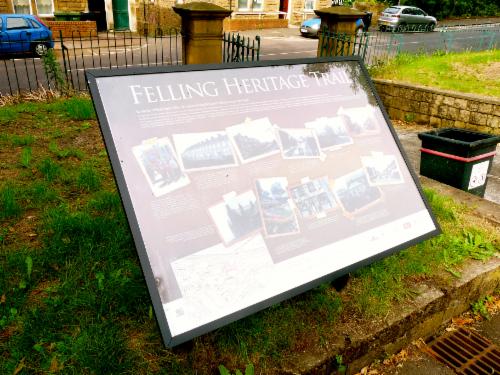
now sporting this interpretation board but very little else...but watch this space
and...
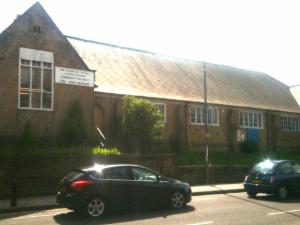
...The House on the Hill, the church hall of Christ Church.
Opposite is the former Police Station, becoming for a while a school of the Gateshead Jewish Community and now vacant1836 August 8. The Brandling Junction Railway was commenced at The Felling. The first turf was cut in the presence of R. W. Brandling, esq., and a party of gentlemen, who had assembled to witness the first effort to forward this desirable undertaking. The Brandling Station was built in 1842. One of the oldest passenger stations in England
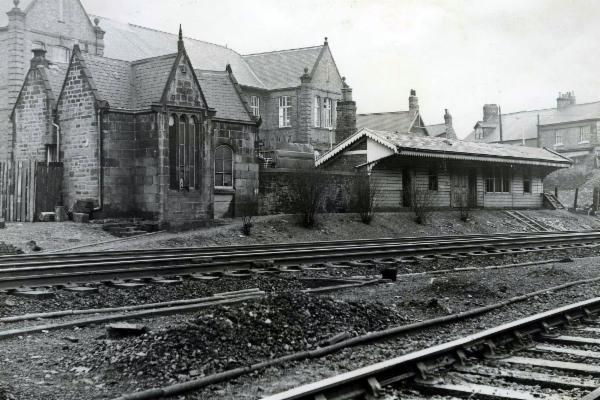
Left click the image to see detail
BR...not British Rail but Brandling Railway
The Car Lines on Sunderland Road

See the new Heritage Trail Signs
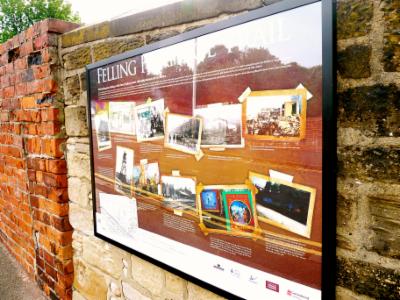
Brandling area, Carlisle Street
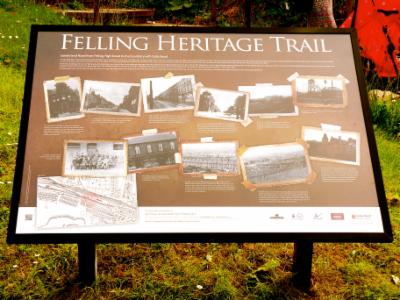
Sunderland Road area
(update: most, if not all, Heritage Trail Signs have now been vandalised to extinction)
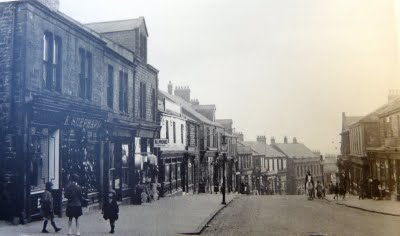
The High Street about the time my Dad was about the age of these kids. He told me he used to look over the wall at the butchers and watched animals being slaughtered
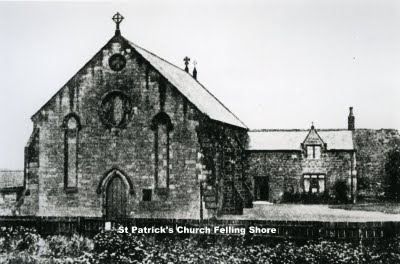
The original St Patrick's RC Chapel was at Felling Shore, built 1842 to satisfy the needs of the huge influx of Irishmen, the descendants of whom are still here
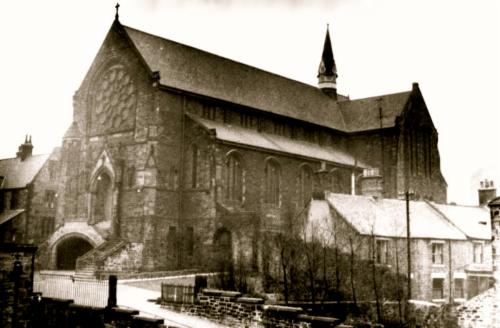
This is the replacement church. St Patrick's RC Church (now a Listed building, as well as the Presbytery), opened on St Patrick's Day 17th March 1895.The scene is looking smarter nowadays
I remember Father Bernard Aloysius Stronge who reigned from 1946-1985.
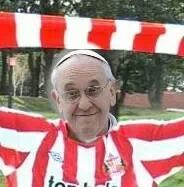
Indeed I now compete for a golf trophy named after him and he has been honoured by Gateshead Council as a Freeman
To be even handed, denominationally speaking, here's St Mary's Church, Heworth
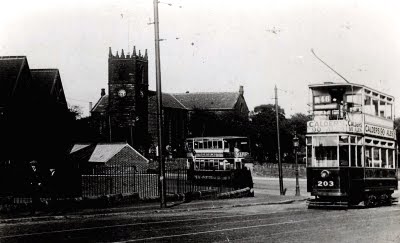
along with Heworth School which stood where the Metro Interchange now stands.
The Rev. Matthew Plummer became curate of St. Mary’s, Heworth in 1831. He was a cultured man, high born. In 1834, when Heworth became a parish in its own right instead of a Chapelry attached to Jarrow parish, Matthew Plummer became the first Vicar of the Parish of Heworth. He remained at Heworth for 46 years
(He was a son of the wealthy Matthew Plummer who owned Sheriff Hill Hall which was built about 1827, after the enclosure of the Gateshead Fell in 1822. Shrewdly, he had acquired many allotments on the Gateshead Fell)
Rev John Hodgson was the first famous vicar, in the Heworth area..it was he who investigated the Felling Pit Disaster, which led to the invention of the Safety Lamp... but in his time the parish was Jarrow & Hebburn
Here's a bit of Heworth Common in 1766, basically fields owned by Charles Brandling, Edward Stewart and others.
Apart from Felling Hall (seen here after it was turned into the Mulberry Tree pub) and

Crow Hall and Cottage, now Listed Buildings,
there's only a few houses clustered around the bottom of Split Crow Road, then called Sunderland Lane as that was the main route from Newcastle to Sunderland.
The predominant part of the area was originally known as Heworth.
Left click to see Council crest above the door
This is the former Felling UDC Council Offices, now a Listed building, used for a time as a Housing Office, then later a refugee, and then a teenagers out of care, lodging. It is now appartments
Above the main door is a crest which was adopted by the Council but was originally the crest of the Brandling family, lords of the manor since the 16th century. The crest comprises an oak log with leaves and acorns attached, and flames coming out the top. Left click the above image to see the detail of the crest
The Urban District of Felling, preceded 30 years earlier by Felling Local Board lasted a mere 80 years, 1894 until 1974 when Local Government Reorganisation resulted in Gateshead being expanded to include The Felling in the East, Birtley in the South and all the way to Crawcrook in the West
On either side of the former Town Hall are The Felling Park
now sporting this interpretation board but very little else...but watch this space
and...
...The House on the Hill, the church hall of Christ Church.
Opposite is the former Police Station, becoming for a while a school of the Gateshead Jewish Community and now vacant
1836 August 8. The Brandling Junction Railway was commenced at The Felling. The first turf was cut in the presence of R. W. Brandling, esq., and a party of gentlemen, who had assembled to witness the first effort to forward this desirable undertaking. The Brandling Station was built in 1842. One of the oldest passenger stations in England

Left click the image to see detail
BR...not British Rail but Brandling Railway
The Car Lines on Sunderland Road

See the new Heritage Trail Signs
Brandling area, Carlisle Street
Sunderland Road area
(update: most, if not all, Heritage Trail Signs have now been vandalised to extinction)
The High Street about the time my Dad was about the age of these kids. He told me he used to look over the wall at the butchers and watched animals being slaughtered

The original St Patrick's RC Chapel was at Felling Shore, built 1842 to satisfy the needs of the huge influx of Irishmen, the descendants of whom are still here

This is the replacement church. St Patrick's RC Church (now a Listed building, as well as the Presbytery), opened on St Patrick's Day 17th March 1895.The scene is looking smarter nowadays
I remember Father Bernard Aloysius Stronge who reigned from 1946-1985.

Indeed I now compete for a golf trophy named after him and he has been honoured by Gateshead Council as a Freeman
To be even handed, denominationally speaking, here's St Mary's Church, Heworth

along with Heworth School which stood where the Metro Interchange now stands.
The Rev. Matthew Plummer became curate of St. Mary’s, Heworth in 1831. He was a cultured man, high born. In 1834, when Heworth became a parish in its own right instead of a Chapelry attached to Jarrow parish, Matthew Plummer became the first Vicar of the Parish of Heworth. He remained at Heworth for 46 years
(He was a son of the wealthy Matthew Plummer who owned Sheriff Hill Hall which was built about 1827, after the enclosure of the Gateshead Fell in 1822. Shrewdly, he had acquired many allotments on the Gateshead Fell)
Rev John Hodgson was the first famous vicar, in the Heworth area..it was he who investigated the Felling Pit Disaster, which led to the invention of the Safety Lamp... but in his time the parish was Jarrow & Hebburn
Also deserving a mention are Christ Church (a Listed building) and St Alban's, the other two Protestant churches. There are also several current and former Methodist chapels
A real gem in Heworth village, in addition to the Heworth Burn, (Felling Commemoration Park) is the Heworth Churchyard with its ancient higgly piggly graves juxaposed with clusters of bluebells and magnificent mature trees, some no doubt from William Falla's World renowned nursery. If you haven't taken a stroll recently I recommend doing the double...the churchyard and the Heworth Burn. They make the current state of Felling Park not worth grieving over.(New group of volunteers may lead to the rebirth of Felling Park)
Thrown in for good measure in the above pic are a couple of trams, one of which is advertising Calders 90/- Ales, which leads me seamlessly from the churches to...
Also deserving a mention are Christ Church (a Listed building) and St Alban's, the other two Protestant churches. There are also several current and former Methodist chapels
A real gem in Heworth village, in addition to the Heworth Burn, (Felling Commemoration Park) is the Heworth Churchyard with its ancient higgly piggly graves juxaposed with clusters of bluebells and magnificent mature trees, some no doubt from William Falla's World renowned nursery. If you haven't taken a stroll recently I recommend doing the double...the churchyard and the Heworth Burn. They make the current state of Felling Park not worth grieving over.(New group of volunteers may lead to the rebirth of Felling Park)
Thrown in for good measure in the above pic are a couple of trams, one of which is advertising Calders 90/- Ales, which leads me seamlessly from the churches to...
EARLY INDUSTRY
Coal Mining at Felling, Heworth and Follonsby, Coal exportation and Shipbuilding at Felling Shore, Potteries at Heworth and Quarrying at Windy Nook and Heworth
Let's get Pottery out of the way first. Such as I know is here
Moving on....
Stone quarrying was the main industry in Windy Nook, as well as Felling and Heworth. There were several quarries with the largest being Kell's Quarry, providing sandstone and grindstone. Newcastle grindstones were World famous but they were Windy Nook grindstones just as most coals from Newcastle came from Gateshead/Felling. Windy Nook, including its quarries, is dealt with in more detail, later on this page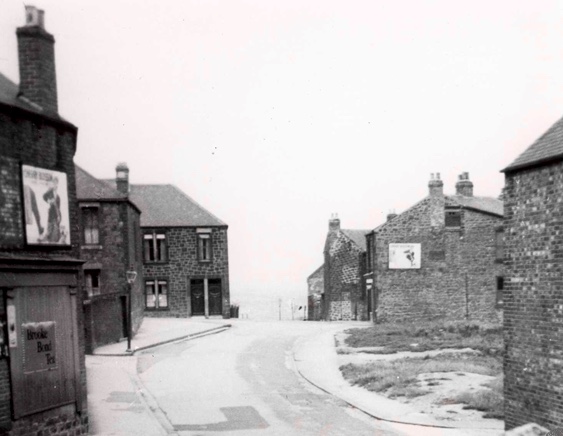
Wellington Street, close to Felling Quarry ("Bankies")
Brickmaking




Fosters Brick Making Works was at Stoneygate and Pelaw. William Foster was in the right place at the right time when he landed a contract to make bricks for the massive building programme of the Co-operative Wholesale Society at Pelaw. Click the link to see Wm. Foster's house. Click here to see William Foster. Look below at the last brick in the wall and see that Wm Foster, perhaps, did not have the CWS gig all to himself. The Pelaw Terra Cotta Works was established in 1895 by Jones and Maxwell. By 1911 Jones Brothers owned the yard and developed it into the largest manufacturer of engineering and facing bricks in the North East. It closed in 1968
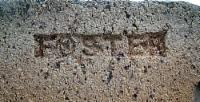
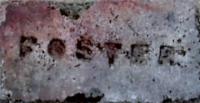


The real big business was Chemicals, and Coal was prominent for a while...stay tuned for more...coming soon
THE PUBS
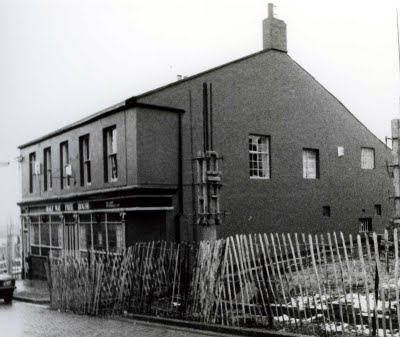
Once, the oldest remaining pub building, The Half Way House on Felling High Street of about 1835 said to be half way between Low and High Felling. The building is still there but now converted into flats. This pic shows the start of the revitalisation of the High Street which failed. Left click the image to see how it looked before the conversion of the pub to flats
Opposite this was the Greyhound at 62 High Str., it was demolished and is now at the base of Crowhall Towers.
The name was changed by the female proprietor called Gray to the Gray Hound. She was long gone but the name stayed...so why have a picture of a greyhound? Not very helpful to kids with their spelling. It is now correctly spelled
In Davison Street there was the Oddfellows Arms and Durham Ox, at the bottom of Coldwell Lane there was the Bay Horse, no longer a pub but now on the Council's Local List, not forgetting the Shakespeare, where the Portland is now, also on the Council's Local List,
In 1851 the Barley Mow was occupied by Thomas Dixon. It was acquired by Irish immigrant John White in 1887, the year of the Queen's Jubilee and renamed Victoria Jubilee. John White, & then his widow Martha White, created a pub empire for the next thirty years or so.
Isn't this one, The Bluebell, a magnificent looking Art Nouveau building, rebuilt by Newcastle Breweries in 1905. It's on the Council's Local List, as well as the adjoining top right hand side Felling High Street shops, built in the same red bricks This is a very early brewery owned pub site. The map of 1766 shows the parcel of land, then owned by Robert Whinny,but by 1836 it was in the possession of John Barras. Who was John Barras? Then he had a brewery in Gateshead but in 1884, he was the leading light in establishing Newcastle Breweries
Left click to enlarge
Now let's away down onto Sunderland Road where at Felling Gate there was the Duke of Connaught,( part of the White pub empire mentioned above)
And also The Pear Tree, which is on the Council's Local List,
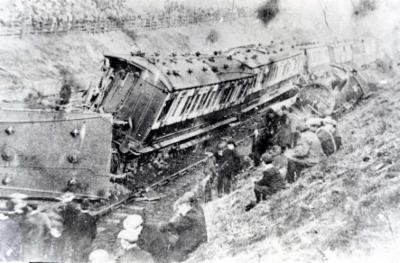
There's a picture which shows the Blink Bonny, with its distinctive shape, opposite the vacant land, now Felling Park, next to Felling Urban District Council Offices
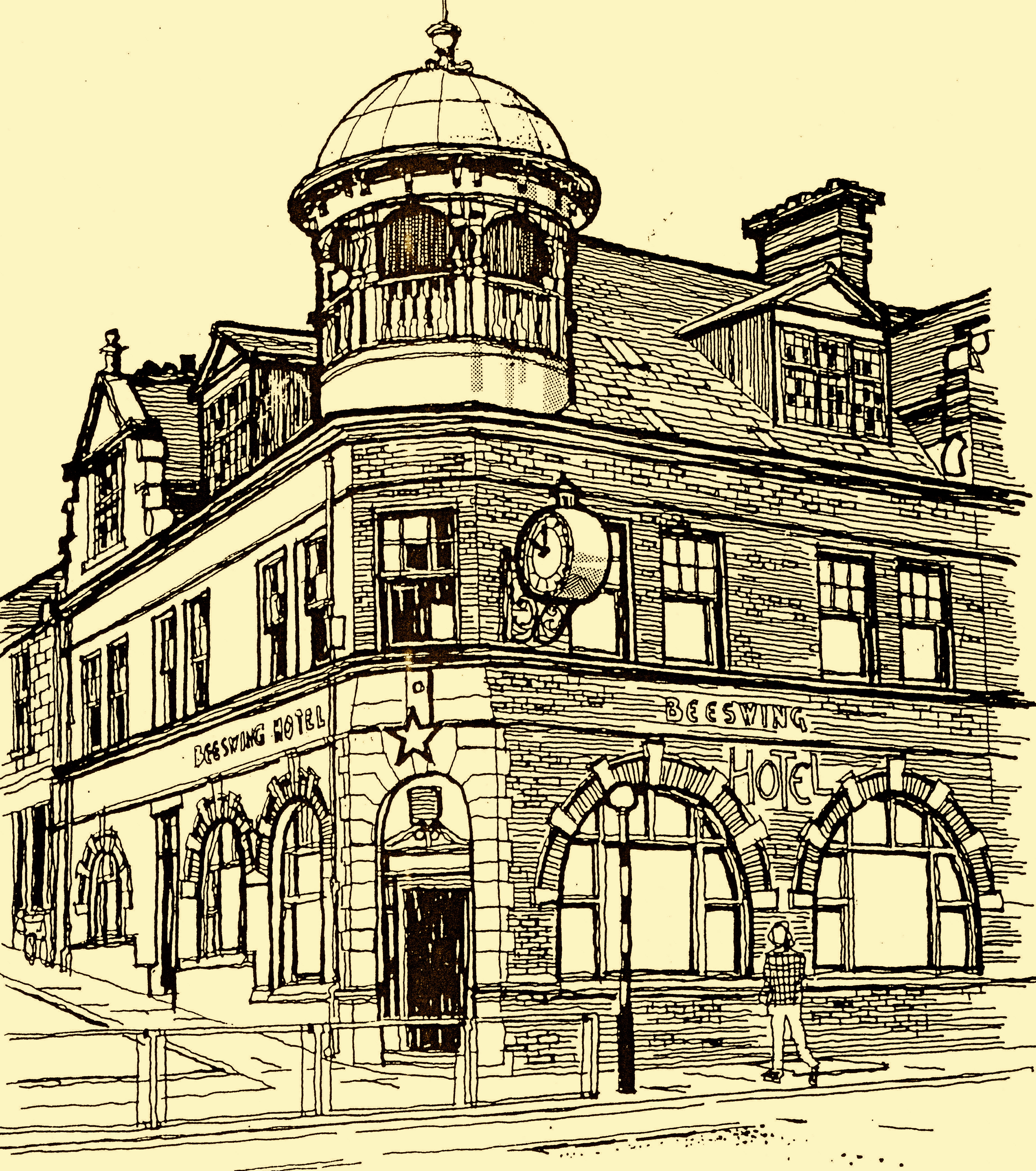
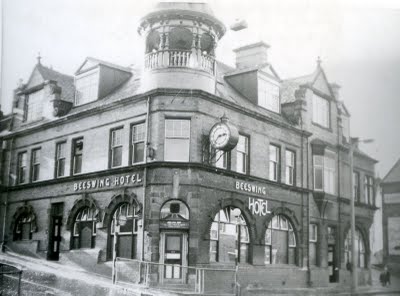
The Bee's Wing as it was first shown, later The Beeswing Hotel then Durty Nellies and once housed refugees. This building is also on the Council's Local List
Named after Bee's Wing, foaled in 1833, this great mare (nicknamed the miner's friend) won the Newcastle Gold Cup 6 times, the Doncaster Gold Cup 4 times and the Ascot Gold Cup in 1842. Another thing The Felling is famous for. Two pubs on the same street named after race horses
Left click to enlarge
The Lord Collingwood pub, and at one time, brewing house, this one shown built 1898, became a Decorating Contractors office, and is now appartments. There was a previous pub because this is a news item for 1862 September 2.
This afternoon Thomas Pigg, landlord of the Lord Collingwood Inn, Felling, met with an untimely death. The deceased took a gun out of the house, saying that he was going into the stable to shoot rats. Shortly after his departure the report of a gun was heard, and on the domestics proceeding to the stable they found the deceased lying dead, the contents of the gun having been discharged into his mouth, and shattered his head severely. The deceased had been formerly a tailor in Newcastle, and had lost his wife only a short time previous. Whether this sad event was the result of accident or intention remains yet to he discovered.
and BELOW THE CAR LINES, more pubs than you can shake a stick at
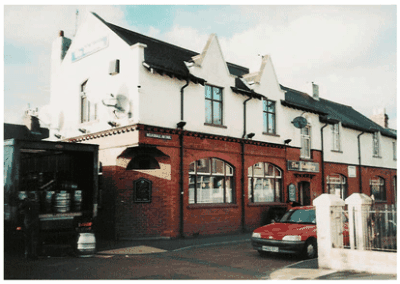
The Mulberry Tree public house emerged in the 1850's by converting Felling Hall, the former seat of the Brandling family. The subsequent Mulberry, shown here, is now no more..the building has been converted into flats
The whole road from Sunderland Road to Felling Shore was Brewery Lane and the name lives on in the Brewery Lane Industrial Estate. The Felling Shore area certainly had it's fair share of pubs, some of which eg Lord Collingwood and the
Malting House (John Humble's Brewery) brewed on the premises.
Left click to enlarge
In what is now Carlisle Street there was the Station Hotel, now the Old Fox, a smashing real ale pub
Left click to see it as it used to be
This one, almost next door, the Wheatsheaf is another smashing real ale pub, now on the Council's Local List
and the Malting House. Left click to see it now
Left click to enlarge
This one, The British Lion is still there but now converted into a shop and other pubs, all of which are now long gone, were The Railway Tavern, The Anchor and the Grindstone in Tyne Street, The Unicorn, The Old Engine, The Wherry, The Moulders Arms, The Brandling Arms, The Ship, The Ferry Boat and the Ferry Hotel (once called The Ferry House) at Friars Goose
In Brewery Lane there was The Bee Hive and
Left click to enlarge
The Green Tree
Slater's Directory of 1855 also lists the Oak Tree..perhaps that was the previous name of the Green Tree
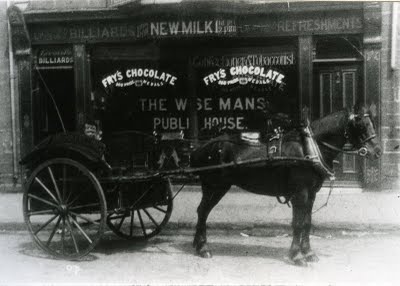
Left click to enlarge
This, The Wise Man's Public House was in Crowhall Lane. A temperance bar in Felling... you wouldn't credit it!
Heworth Lane had the Black Bull and The Squire's Arms
Heworth Shore had The Ellison Arms, The Yarmouth Arms, The Ship Inn, The Shiplaunch and The Red Lion
And then there was the whole of Bill Quay
Here's the pubs listed in Slater's Directory of 1855
Bill Quay had the Albion Inn, The Ship, The Board Inn, The Mason's Arms, The Cricketer's Arms, The Staith House, The Slipway Inn, The Bottle House, The Lamb, The Letter Board and The Shipwright Arms.
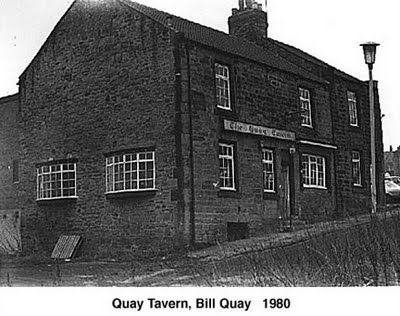
This building is clearly The Cricketer's. Was it originally called The Cricketer's, then in 1980 became the Quay Tavern and then revert back to the original name? Can anybody help?
(Of those listed in Slaters only the Cricketers survives. Albion converted to a house and The Wardley either not built then or had a different name)
Thomas Dixon at Windy Nook had the Black House aka Crown and Thistle, the Engine House, the Coal Waggon and the Waggon. The same directory also lists, at Windy Nook, The Hope and Anchor and the Horse and Hounds (aka Hare and Hounds) Later there was also the Bay Horse and Ravensworth Arms. More here in the Windy Nook extra page
The Ship, famous for being run, in the mid sixties, by one of Mrs Smiths five little boys.
The Five Smith Brothers were locally based but nationally known recording artists eg "When It's Evening" 1947 and "I'm in Favor of Friendship" 1955. Closed for a while, it is now a Premier general dealers shop
My website gateshead pubs has lots more on the pubs of The Felling
The O.S. Map of 1897 shows the Paragon Theatre..incorrectly..it was planned but never built. Ward's directory of 1899 lists the People's Theatre which was demolished sometime before 1905 so that takes us to
THE PICTURES
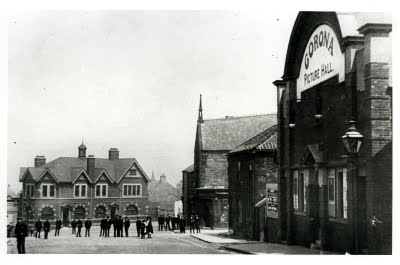
Left click to see the same scene today.
Here's the Corona Picture Hall in Coldwell Lane, opened in 1911 and closed in 1960
Left click to see it bigger
The Imperia Cinema was built in 1910, in Wellington Str.. destroyed by fire in 1929,..
and rebuilt in 1930 at Victoria Square where the Paragon Theatre is shown on the OS Map...this is an unusual OS mistake...the Paragon Theatre was never built, ..later a Palais de Dance was added. Folks referred to the Cinema as the Pally
The Palais and Imperial Cinema are now a Bookmakers shop and Bingo Hall respectively. Both are Grade II Listed buildings
Left click to enlarge
Felling Lodge as it is today
It was built for the surgeon Mr Lammas in 1827.Subsequently it was the home of the surveyor at Felling Colliery and later
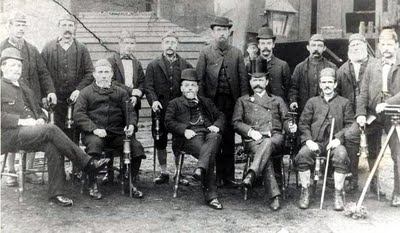
Left click to enlarge
Doctor Kelly, then Dr Millar and then Dr Cosgrove. This is Dr Kelly, in the top hat, along with other big wigs from Felling Colliery
SHOPS ON THE HIGH STREET
Thomas Sisterson's Drug Store on the High Street, Nos 92-96, next one down to what was Woolworth's
John M. Costelloe had a number of pawnshops in Gateshead and he built Costelloe's Building in 1907 (No 56).
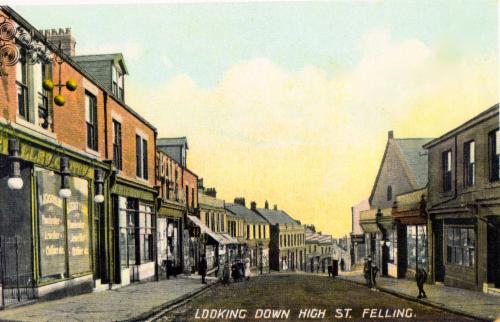
This was until 2008 occupied by Sauls, the wallpaper and paint people,
Left click to enlarge
but the ornate support, that used to carry the three gold balls of the pawnbrokers sign is still in place. (see the support and the balls in the top left hand corner of the picture above) It should be taken to Beamish Museum, in my view, where it will be seen, appreciated and preserved.
I would like my great grandkids to be able to see where my Grandma pawned my Grandad's best suit
Almost opposite this pawnshop was another run by Ernest Walters (No 35) which had started off in the Walters' home in Davidson Street
Walter Willsons shop was converted from a chapel
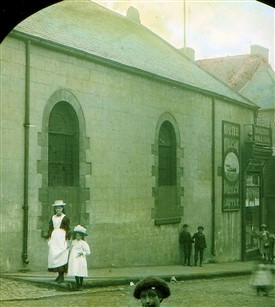
Another view shortly after the conversion from Chapel to shop. For more on Wesleyan chapels history
http://www.mywesleyanmethodists.org.uk/page_id__38_path__0p4p13p.aspx
CUBE PIT Area...
or "Q" Pit as most called it (wrongly, but for so longly it's become rightly)
This is Split Crow Road in the area known by Felling folk as Cube Pit or "Q" Pit. This puzzled me since the pit was called William Pit,
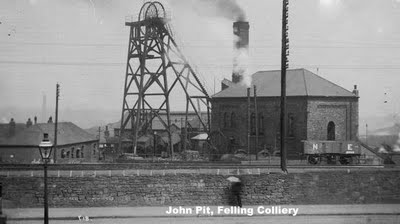
the other was John Pit named after the two Brandling brothers who owned Felling Colliery. I have found the answer in a dictionary of mining terms. It was, a ventilation shaft, a cube defined as follows
CUBE, OR CUPOLA. — A shaft sunk near to the top of a furnace upcast (a ventilation shaft with a fire at the bottom), and holed into the shaft a few fathoms below the surface, with a wide chimney erected over it, rising 30 or 40 feet above the surface. It relieves the pit top from smoke
See the chimney shown on the map
Elsewhere I have seen the whole ventilation arrangement of using a furnace to create rising heated foul air and descending cold clean air as the cube or even calling the furnace fire itself the cube as in "the explosion occured because the cube had been allowed to go out"
Many people used to say "Q" Pit but that was almost certainly a mishearing of Cube Pit. If you don't believe me, go here
The Felling Colliery had a major explosion on Monday morning 25th May 1812.
(It is possible..maybe probable.. that the cause was a build up of explosive gasses because the Cube (furnace) was allowed to go out over the weekend. Rev. John Hodgson who investigated this Pit Disaster refused to state in his report this, or any other, potential cause.
A fire broke forth with two eruptions from the John Pit, which were almost instantaneously followed by one from the William Pit. A slight trembling, as from an earthquake, was felt for about half a mile around the workings; and the noise of the explosion, though dull, was heard three or four miles away. Immense quantities of dust, and some free coal, accompanied these blasts. Just saying.
Ninety-two were victim miners, the majority, fifty two, were also minors.
T'was rotting brands that had formed the coal
T'was flames that blew minors (sic) to buggary
A rotten business, on the whole
(Provocative Poet)
Whilst occurring in vein, seams t'was not in vain. The safety lamp was developed following the tragedy. In 2012, The Bicentennial, the tragedy was commemorated and here is the full story on The Felling website
The Streets adjacent to Cube Pit (Q) running down towards the Quarry ( later known as "The Bankies") were Kenmir Street, Elsdon Street, Fox Street, George Street, Ann Street, Osborne Terrace, Thomas Street, Ladysmith Street, Buller Street, Norman Street, Catherine Tce, Christies Lane,
FELLING SHORE
left click to enlarge
WARDLEY
Pubs in Wardley were the Colliery Inn,
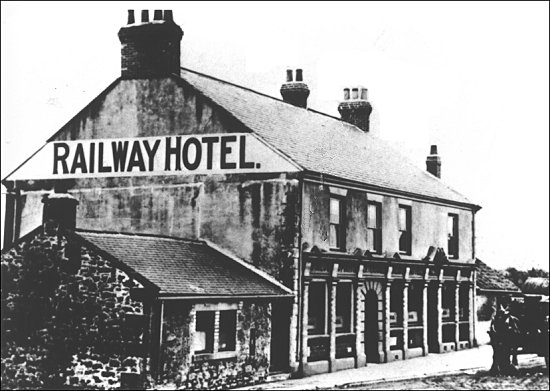
this one, the Railway Inn, the low section on the left being a temperance bar and ...
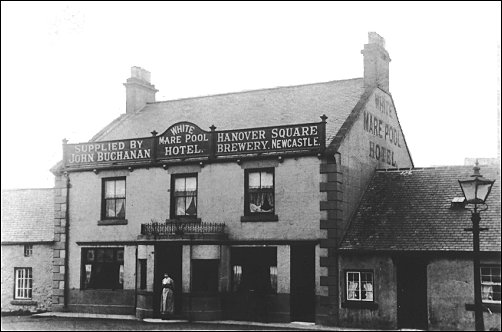
...The White Mare Pool Hotel, later the Dixielanders, was a listed building which, when being converted to the Green, they discovered that the foundations of the extension were defective and so pulled down the main building.
Note the old Poor House on the High Str. and
Left click to enlarge
the posh houses, still there along Holly Hill. On the left is Holly Villa, now divided into two properties. The one on the right is Ardallen (1847). It is a Grade II Listed Building. One of the Felling's industrialists, Thomas Gallon who manufactured paper had it built, indeed it was the first house on Holly Hill field. Its surrounding walls, gate pillar and gate are also listed.
Note the Traveller's Rest pub on Sunderland Road... look back at Slater's directory and see there was no such pub in 1855. Could it be the then Lord Collingwood? The Battle of Trafalgar was 1805 and Cuthbert Collingwood, the Northumbrian hero of the battle was no doubt honoured in his name being given to the pub.
FELLING STAITHES
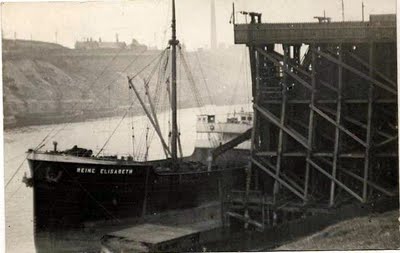
Left click to enlarge
A long wooden waggonway led to Felling Shore Staithes. This was the Washington Waggonway or Great Grindstone Way. It was seven miles long, extending from Washington, via Usworth, crossing Leam Lane, between Springwell Inn and Wallace Village and ran north of the Fell Dyke past White House. From there it followed Battery Lane to Stone Street, crossed Windy Nook Road to the present Black House Inn (then called the Waggon Inn) and went down Coldwell Terrace and Felling High Street to Brewery Lane. Just beyond Felling Hall it turned westward to the staithes.
THE HISTORY OF HIGH HEWORTH / WINDY NOOK
Left click to enlarge
White House was for many years left derelict. The White House, or Old Hall, occupied 'the high road betwixt the vales of the Wear and Tyne, commanding a very varied and extensive prospect over the estuary of both rivers, with the parishes of Tynemouth and Hylton in the distance' It was one of the oldest habitations in Heworth, appearing in the Durham Priory Household Book of 1530. During the English Civil War, it was the seat of the staunchly Catholic Jennison family. Edward Colvin or Colvil, a butcher, grazier and import merchant lived there until his death in 1750. The house was then owned by John Stafford
It is still shown on the map below which is dated about 1970 just before the new road and Whitehills Estate was built
Left click on image to enlarge
This also shows Albion Street and the Windy Nook Quarries
Windy Nook Quarry...wasn't it deep?
It was all backfilled and that's why to this day it is not built on.. which is great. Indeed all the nice pockets of green around The Felling are because of quarries.
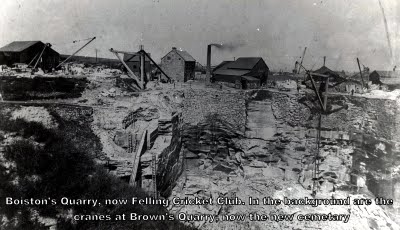
Left click to enlarge
Felling Cricket pitch, the Cemetery on Watermill Lane and the adjacent "dene" was Low Burn Quarry (aka Brown's Quarry) and the "Bankies", the big landscaped area off Sunderland Road to the right of the High Street (looking upwards) was Felling Quarry
Left click to enlarge
Albion Street, Windy Nook
Well down the street at High Heworth there was the Duke of Cumberland,(now on Sunderland Road) and the Ravensworth Arms, but known as Finnigan's and now named the Fiddlers Three
Hare and Hounds, Windy Nook. (originally called Horse and Hounds)
There was also the Bay Horse, the Crown and Thistle, the Engine House, the Hope and Anchor (known for the last landlord as Perry Norman's..(located nearly opposite The Black House..just one building (Billy the Barber) further down Coldwell Lane) when demolished the licence was transferred to the newly built Eagle on the Leam ) and the Black House (originally called the Coal Waggon) and now a Tesco shop. See new thoughts on the multiple names of the Black House here)
Before leaving Windy Nook the "ancient fortress" is worth a mention
It's actually a colliery slag heap to which sculptor Richard Cole, in 1986, added earth and 2500 tons of granite stone salvaged from the pillars supporting the old Scotswood Bridge to form this 'Public Work of Art'...a real asset... to glue sniffers and underage drinkers, unfortunately. Here's a bit more on Windy Nook
And, now, a brief mention of some of the Felling characters, real or mythical. 1836 April 2. Mr. William Falla, nurseryman, of Gateshead, left his home, and was never afterwards seen alive. On the first of May his body was accidentally discovered in a very shocking state in Ravensworth Wood, near Ladypark farm. It was then found that the deceased had committed suicide by piercing his windpipe with a pen-knife, an instrument which he had closed and replaced in his pocket after committing the act.
Certainly real was a zany friend of my Grandma called Joe Forsyth but known as Joe Bleak. I'm not sure if he was touched or just eccentric. And then, who was Nanny Figgy? And what about Cat Nancy who killed cats and sold the meat as rabbit.
Mary Elizabeth Wilson, a resident of Windy Nook achieved worldwide notoriety as the "Merry Widow of Windy Nook" For the full story
Windy Nook History Society's History Page
Windy Nook History Society Meetings/Outings
Let's finish with this.
Here is a representation of an Edward VIII Royal Cypher. Edward VIII only reigned for a few months in 1936 before abdicating.
Here’s the cypher that may be seen on a postbox and there are only about 100 of these still in existence in the Country (it's believed there's still one in Newcastle)
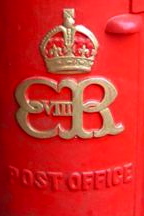
Here’s an example of the Edward VIII cypher on a building
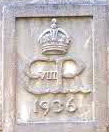
but there are very few buildings in the World that bear the Royal Cypher of Edward VIII because of his short reign.
There are none in the North East of England, except for one... in the heart of The Felling...how special is that!
And here...roll of drums... is the Edward VIII Royal Cypher on that current building in The Felling
The following are sub pages reachable by links among the text throughout the website. However if you see a topic below that is of interest you can click the link